2013 Peugeot 3008 Hybrid 4 ECO mode
[x] Cancel search: ECO modePage 32 of 340
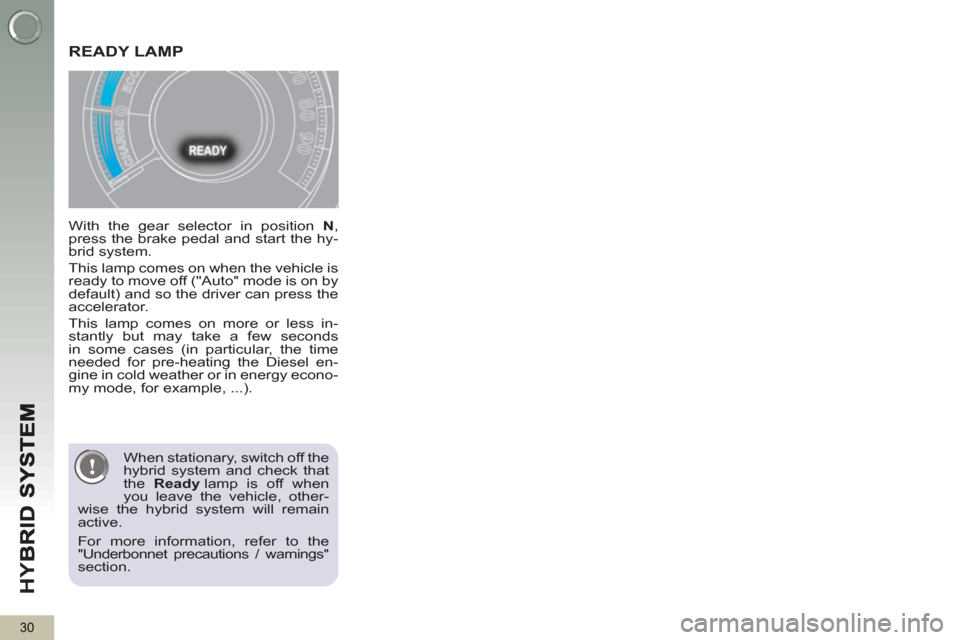
HY
B
30
With the gear selector in position N
,
press the brake pedal and start the hy-
brid system.
This lamp comes on when the vehicle is
ready to move off ("Auto" mode is on by
default) and so the driver can press the
accelerator.
This lamp comes on more or less in-
stantly but may take a few seconds
in some cases (in particular, the time
needed for pre-heating the Diesel en-
gine in cold weather or in energy econo-
my mode, for example, ...).
READY LAMP
When stationary, switch off the
hybrid system and check that
the Ready
lamp is off when
you leave the vehicle, other-
wise the hybrid system will remain
active.
For more information, refer to the
"Underbonnet precautions / warnings"
section.
Page 34 of 340
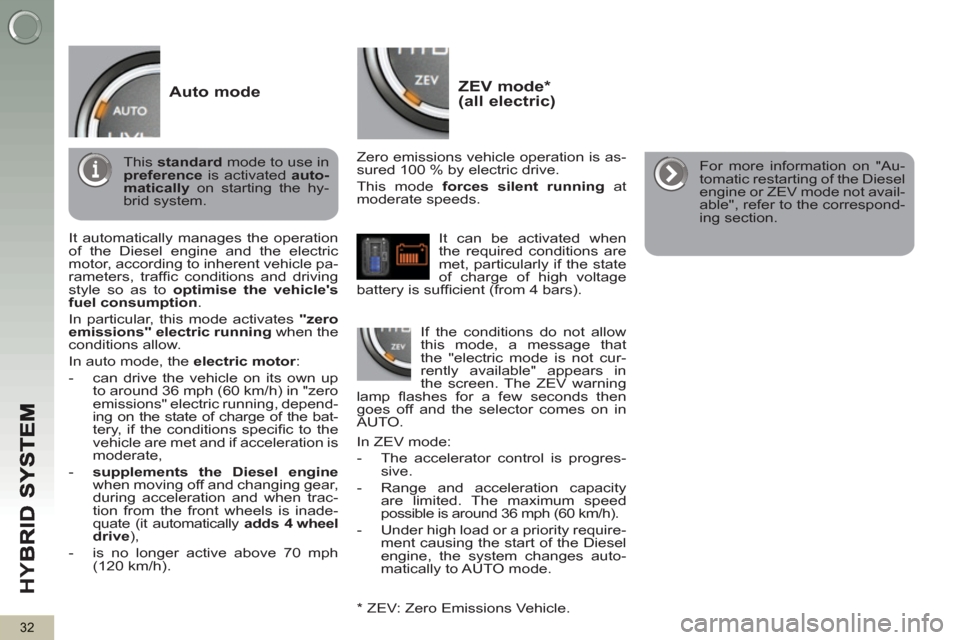
HY
B
32
ZEV mode * (all electric)
Zero emissions vehicle operation is as-
sured 100 % by electric drive.
This mode forces silent running
at
moderate speeds.
* ZEV: Zero Emissions Vehicle. In ZEV mode:
- The accelerator control is progres-
sive.
- Range and acceleration capacity
are limited. The maximum speed
possible is around 36 mph (60 km/h).
- Under high load or a priority require-
ment causing the start of the Diesel
engine, the system changes auto-
matically to AUTO mode.
It can be activated when
the required conditions are
met, particularly if the state
of charge of high voltage
battery is suffi cient (from 4 bars).
If the conditions do not allow
this mode, a message that
the "electric mode is not cur-
rently available" appears in
the screen. The ZEV warning
lamp fl ashes for a few seconds then
goes off and the selector comes on in
AUTO.
Auto mode
It automatically manages the operation
of the Diesel engine and the electric
motor, according to inherent vehicle pa-
rameters, traffi c conditions and driving
style so as to optimise the vehicle's
fuel consumption
.
In particular, this mode activates "zero
emissions" electric running
when the
conditions allow.
In auto mode, the electric motor
:
- can drive the vehicle on its own up
to around 36 mph (60 km/h) in "zero
emissions" electric running, depend-
ing on the state of charge of the bat-
tery, if the conditions specifi c to the
vehicle are met and if acceleration is
moderate,
- supplements the Diesel engine
when moving off and changing gear,
during acceleration and when trac-
tion from the front wheels is inade-
quate (it automatically adds
4 wheel
drive
),
- is no longer active above 70 mph
(120 km/h).
This standard
mode to use in
preference
is activated auto-
matically
on starting the hy-
brid system.
For more information on "Au-
tomatic restarting of the Diesel
engine or ZEV mode not avail-
able", refer to the correspond-
ing section.
Page 35 of 340
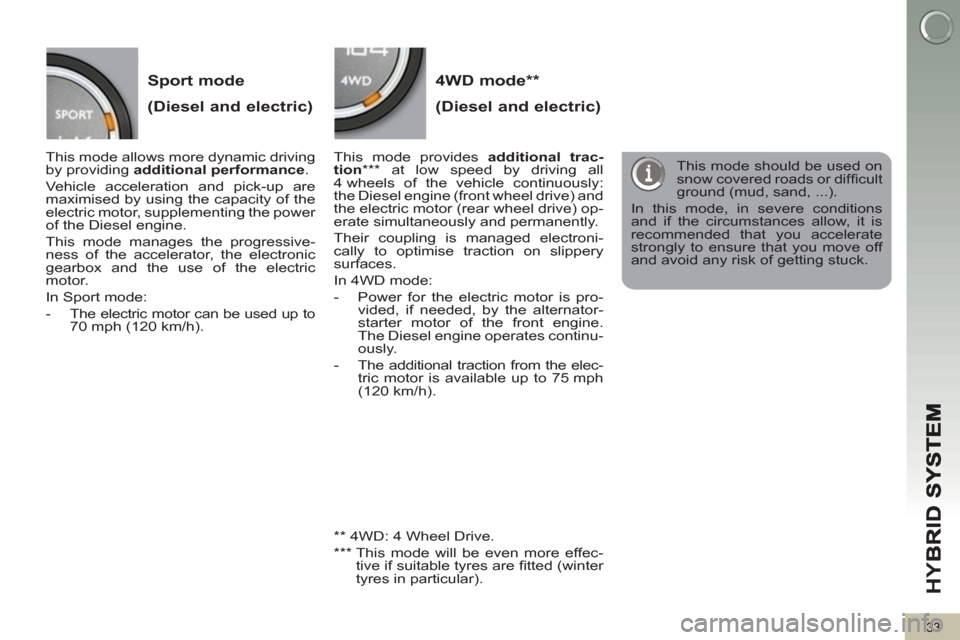
HY
B
33
Sport mode
(Diesel and electric)
4WD mode **
(Diesel and electric)
This mode allows more dynamic driving
by providing additional performance
.
Vehicle acceleration and pick-up are
maximised by using the capacity of the
electric motor, supplementing the power
of the Diesel engine.
This mode manages the progressive-
ness of the accelerator, the electronic
gearbox and the use of the electric
motor.
In Sport mode:
- The electric motor can be used up to
70 mph (120 km/h).
This mode provides additional trac-
tion
*** at low speed by driving all
4 wheels of the vehicle continuously:
the Diesel engine (front wheel drive) and
the electric motor (rear wheel drive) op-
erate simultaneously and permanently.
Their coupling is managed electroni-
cally to optimise traction on slippery
surfaces.
In 4WD mode:
- Power for the electric motor is pro-
vided, if needed, by the alternator-
starter motor of the front engine.
The Diesel engine operates continu-
ously.
- The additional traction from the elec-
tric motor is available up to 75 mph
(120 km/h).
This mode should be used on
snow covered roads or diffi cult
ground (mud, sand, ...).
In this mode, in severe conditions
and if the circumstances allow, it is
recommended that you accelerate
strongly to ensure that you move off
and avoid any risk of getting stuck.
**
4WD: 4 Wheel Drive.
***
This mode will be even more effec-
tive if suitable tyres are fi tted (winter
tyres in particular).
Page 37 of 340
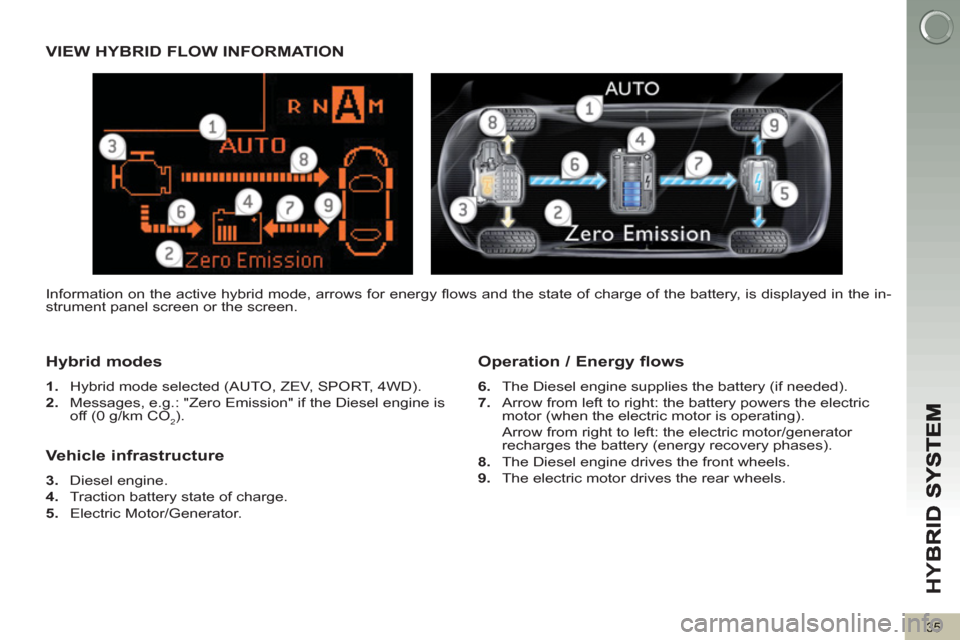
HY
B
35
VIEW HYBRID FLOW INFORMATION
H
ybrid modes
1.
Hybrid mode selected (AUTO, ZEV, SPORT, 4WD).
2.
Messages, e.g.: "Zero Emission" if the Diesel engine is
off (0 g/km CO
2).
Operation / Energy flows
6.
The Diesel engine supplies the battery (if needed).
7.
Arrow from left to right: the battery powers the electric
motor (when the electric motor is operating).
Arrow from right to left: the electric motor/generator
recharges the battery (energy recovery phases).
8.
The Diesel engine drives the front wheels.
9.
The electric motor drives the rear wheels.
Vehicle infrastructure
3.
Diesel engine.
4.
Traction battery state of charge.
5.
Electric Motor/Generator. Information on the active hybrid mode, arrows for energy fl ows and the state of charge of the battery, is displayed in the in-
strument panel screen or the screen.
Page 38 of 340
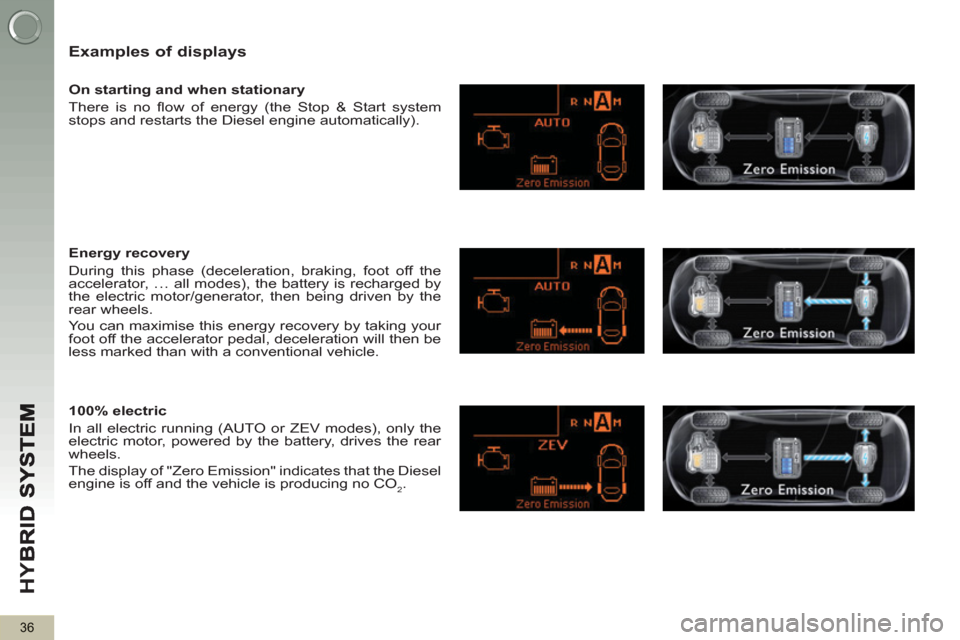
HY
B
36
Examples of displays
On starting and when stationary
There is no fl ow of energy (the Stop & Start system
stops and restarts the Diesel engine automatically).
Energy recovery
During this phase (deceleration, braking, foot off the
accelerator, … all modes), the battery is recharged by
the electric motor/generator, then being driven by the
rear wheels.
You can maximise this energy recovery by taking your
foot off the accelerator pedal, deceleration will then be
less marked than with a conventional vehicle.
100% electric
In all electric running (AUTO or ZEV modes), only the
electric motor, powered by the battery, drives the rear
wheels.
The display of "Zero Emission" indicates that the Diesel
engine is off and the vehicle is producing no CO
2.
Page 39 of 340
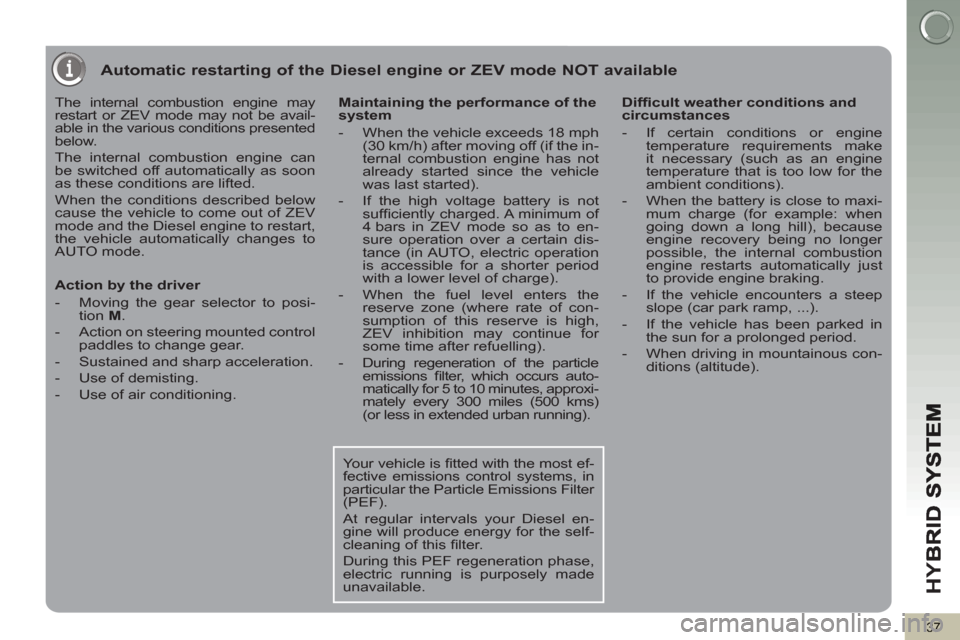
HY
B
37
Automatic restarting of the Diesel engine or ZEV mode NOT available
The internal combustion engine may
restart or ZEV mode may not be avail-
able in the various conditions presented
below.
The internal combustion engine can
be switched off automatically as soon
as these conditions are lifted.
When the conditions described below
cause the vehicle to come out of ZEV
mode and the Diesel engine to restart,
the vehicle automatically changes to
AUTO mode.
Action by the driver
- Moving the gear selector to posi-
tion M
.
- Action on steering mounted control
paddles to change gear.
- Sustained and sharp acceleration.
- Use of demisting.
- Use of air conditioning.
Maintaining the performance of the
system
- When the vehicle exceeds 18 mph
(30 km/h) after moving off (if the in-
ternal combustion engine has not
already started since the vehicle
was last started).
- If the high voltage battery is not
suffi ciently charged. A minimum of
4 bars in ZEV mode so as to en-
sure operation over a certain dis-
tance (in AUTO, electric operation
is accessible for a shorter period
with a lower level of charge).
- When the fuel level enters the
reserve zone (where rate of con-
sumption of this reserve is high,
ZEV inhibition may continue for
some time after refuelling).
- During regeneration of the particle
emissions fi lter, which occurs auto-
matically for 5 to 10 minutes, approxi-
mately every 300 miles (500 kms)
(or less in extended urban running).
Diffi cult weather conditions and
circumstances
- If certain conditions or engine
temperature requirements make
it necessary (such as an engine
temperature that is too low for the
ambient conditions).
- When the battery is close to maxi-
mum charge (for example: when
going down a long hill), because
engine recovery being no longer
possible, the internal combustion
engine restarts automatically just
to provide engine braking.
- If the vehicle encounters a steep
slope (car park ramp, ...).
- If the vehicle has been parked in
the sun for a prolonged period.
- When driving in mountainous con-
ditions (altitude).
Your vehicle is fi tted with the most ef-
fective emissions control systems, in
particular the Particle Emissions Filter
(PEF).
At regular intervals your Diesel en-
gine will produce energy for the self-
cleaning of this fi lter.
During this PEF regeneration phase,
electric running is purposely made
unavailable.
Page 40 of 340
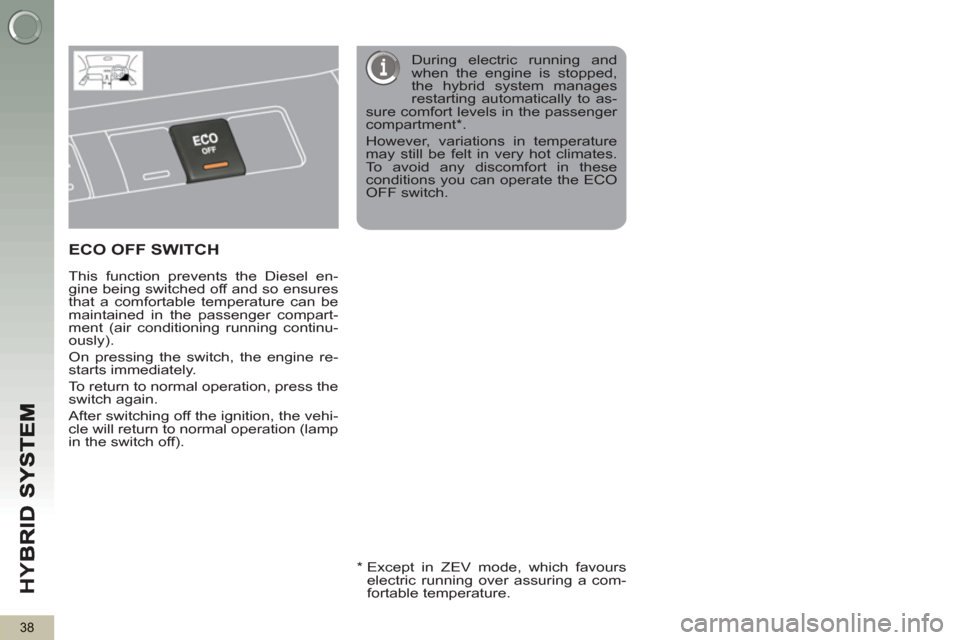
HY
B
38
ECO OFF SWITCH
This function prevents the Diesel en-
gine being switched off and so ensures
that a comfortable temperature can be
maintained in the passenger compart-
ment (air conditioning running continu-
ously).
On pressing the switch, the engine re-
starts immediately.
To return to normal operation, press the
switch again.
After switching off the ignition, the vehi-
cle will return to normal operation (lamp
in the switch off).
During electric running and
when the engine is stopped,
the hybrid system manages
restarting automatically to as-
sure comfort levels in the passenger
compartment * .
However, variations in temperature
may still be felt in very hot climates.
To avoid any discomfort in these
conditions you can operate the ECO
OFF switch.
*
Except in ZEV mode, which favours
electric running over assuring a com-
fortable temperature.
Page 41 of 340
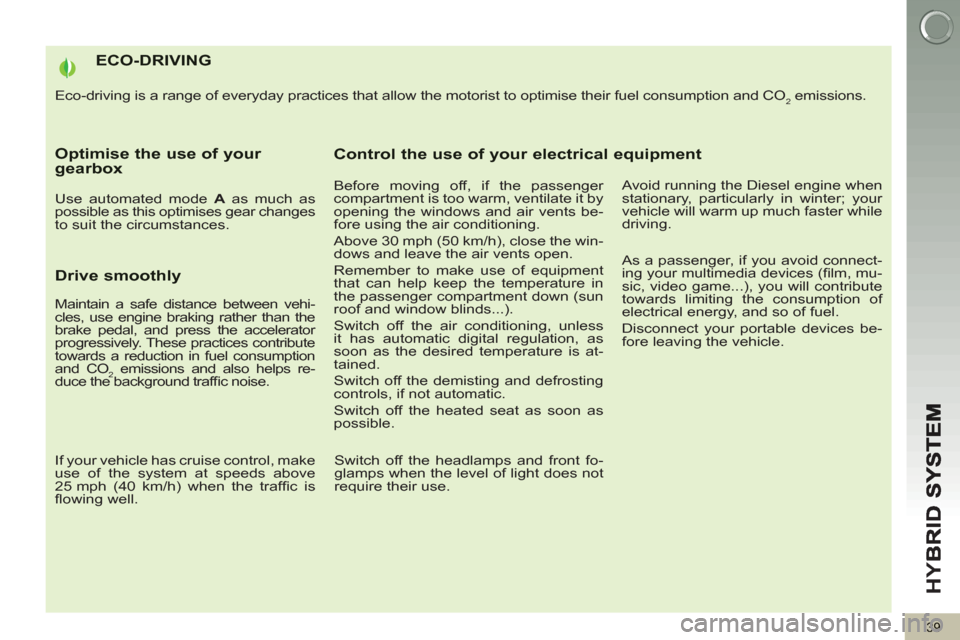
HY
B
39
ECO-DRIVING
Eco-driving is a range of everyday practices that allow the motorist to optimise their fuel consumption and CO2 emissions.
Optimise the use of your gearbox
Use automated mode A
as much as
possible as this optimises gear changes
to suit the circumstances.
Drive smoothly
If your vehicle has cruise control, make
use of the system at speeds above
25 mph (40 km/h) when the traffi c is
fl owing well.
Control the use of your electrical equipment
Before moving off, if the passenger
compartment is too warm, ventilate it by
opening the windows and air vents be-
fore using the air conditioning.
Above 30 mph (50 km/h), close the win-
dows and leave the air vents open.
Remember to make use of equipment
that can help keep the temperature in
the passenger compartment down (sun
roof and window blinds...).
Switch off the air conditioning, unless
it has automatic digital regulation, as
soon as the desired temperature is at-
tained.
Switch off the demisting and defrosting
controls, if not automatic.
Switch off the heated seat as soon as
possible.
Switch off the headlamps and front fo-
glamps when the level of light does not
require their use.
Avoid running the Diesel engine when
stationary, particularly in winter; your
vehicle will warm up much faster while
driving.
As a passenger, if you avoid connect-
ing your multimedia devices (fi lm, mu-
sic, video game...), you will contribute
towards limiting the consumption of
electrical energy, and so of fuel.
Disconnect your portable devices be-
fore leaving the vehicle.
Maintain a safe distance between vehi-
cles, use engine braking rather than the
brake pedal, and press the accelerator
progressively. These practices contribute
towards a reduction in fuel consumption
and CO
2 emissions and also helps re-
duce the background traffi c noise.